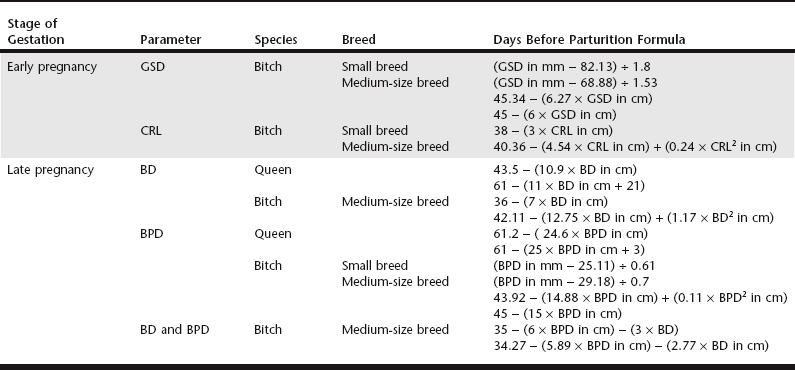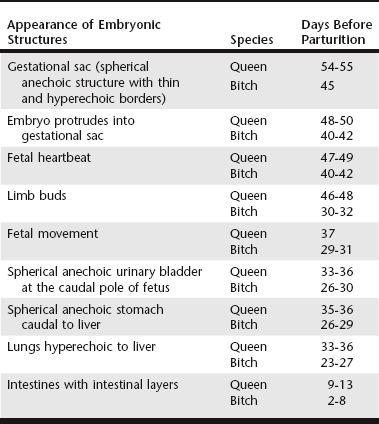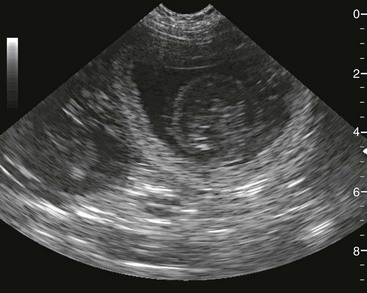Chapter 207 Abdominal palpation is used frequently because it does not require expensive equipment; however, the skill and experience of the practitioner can be a variable. The best time to perform palpation in bitches is between 25 and 35 days after the luteinizing hormone (LH) surge. For queens, palpation is recommended between day 21 and 25 after breeding, at which time the fetal vesicles are approximately 2.5 cm in diameter (Johnston, Root Kustritz, and Olson, 2001b). During this time, amnionic vesicles can be palpated within the uterus, usually with the patient in a standing position. This technique is most successful in dams that are not overweight or overly tense. If the first examination reveals no palpable vesicles, then the procedure should be repeated 1 week later. A disadvantage of this technique is that a fluid-filled uterus can be misinterpreted as pregnancy in some cases, especially in a saccular form of pyometra. Any bitch or queen with palpable swelling in the uterus also should be checked for vaginal discharge, and the owner should be asked general health questions regarding polyuria, polydispsia, vomiting, lethargy, or unusual interest by males, which can be symptoms of pyometra. Another method of diagnosing pregnancy is with real-time (B-mode) ultrasonography. Ultrasound is the application of sound waves to the abdomen that reflect off of different tissues to create an image on the monitor. This technique is one of the preferred methods for determining pregnancy. Ultrasonography can be performed with the patient in dorsal recumbency or standing position. The advantages of ultrasonography include the identification of amnionic vesicles (as early as 21 days after LH surge for bitches and as early as 16 to 25 days after breeding for queens), embryonic/fetal structures, and fetal heartbeat (as early as 25 days after LH surge). An accurate fetal count usually can be achieved in bitches between 30 and 37 days from LH surge (Figure 207-1) and in queens from day 28 to 35 from breeding. With experience and training, gestational age can be determined quantitatively (Table 207-1) as well as qualitatively (Table 207-2). The main disadvantage of ultrasonography is the cost of the equipment and experience necessary for an accurate interpretation. TABLE 207-1 Using Transabdominal Ultrasonography, Days Before Parturition Determined Quantitatively in Queens and Small to Medium-Size Bitches by Applying Gestational Sac Diameter, Crown-Rump Length, Body Diameter, and Biparietal Diameter Measurements into Formulas BD, Body diameter; BPD, biparietal diameter; CRL, crown rump length; GSD, gestational sac diameter. Data from Davidson AP, Baker TW: Reproductive ultrasound of the bitch and queen, Top Companion Anim Med 24:55, 2009; Michel E et al: Prediction of parturition date in the bitch and queen, Reprod Dom Anim 46:926, 2011. TABLE 207-2 Using Transabdominal Ultrasonography, Days Before Parturition as Determined Qualitatively in Queens and Bitches by Identifying Changes in Embryonic Structures Data from Johnston SD, Root Kustritz MV, Olson PNS: Canine pregnancy. In Johnston SD, Root Kustritz MV, Olson PNS, editors: Canine and feline theriogenology, Philadelphia, 2001, WB Saunders, p 66; Johnston SD, Root Kustritz MV, Olson PNS: Feline pregnancy. In Johnston SD, Root Kustritz MV, Olson PNS, editors: Canine and feline theriogenology, Philadelphia, 2001, WB Saunders, p 414; Michel E et al: Prediction of parturition date in the bitch and queen, Reprod Dom Anim 46:926, 2011. Figure 207-1 Transabdominal ultrasonography performed on a bitch 33 to 35 days after breeding (37 days after LH surge). Two fetuses can be identified readily in this view.
Pregnancy Diagnosis in Companion Animals
Methods for Pregnancy Diagnosis
Abdominal Palpation
Abdominal Ultrasonography



![]()
Stay updated, free articles. Join our Telegram channel

Full access? Get Clinical Tree


Pregnancy Diagnosis in Companion Animals
Only gold members can continue reading. Log In or Register to continue
